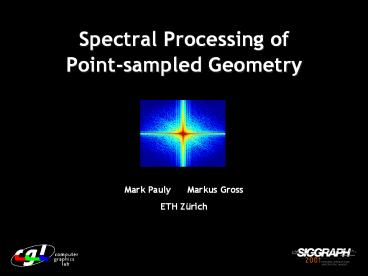Spectral%20Processing%20of%20Point-sampled%20Geometry - PowerPoint PPT Presentation
Title:
Spectral%20Processing%20of%20Point-sampled%20Geometry
Description:
Spectral Processing of. Point-sampled Geometry. Mark Pauly Markus Gross. ETH Z rich ... Extend Fourier transform to 2-manifold surfaces. Spectral representation ... – PowerPoint PPT presentation
Number of Views:64
Avg rating:3.0/5.0
Title: Spectral%20Processing%20of%20Point-sampled%20Geometry
1
Spectral Processing of Point-sampled Geometry
Mark Pauly Markus Gross ETH Zürich
2
Outline
- Introduction
- Spectral processing pipeline
- Results
- Conclusions
3
Introduction
Introduction
- Model
- Acquisition
- Range scans
- Depth images
- Point
- Rendering
- QSplat
- Surfels
4
Spectral Transform
Introduction
- Extend Fourier transform to 2-manifold surfaces
- Spectral representation of point-based objects
- Powerful methods for digital geometry processing
5
Applications
Introduction
- Spectral filtering
- Noise removal
- Microstructure analysis
- Enhancement
- Adaptive resampling
- Complexity reduction
- Continuous LOD
6
Fourier Transform
Introduction
- Benefits
- Sound concept of frequency
- Extensive theory
- Fast algorithms
- Limitations
- Euclidean domain, global parameterization
- Regular sampling
- Lack of local control
7
Overview
Spectral Processing Pipeline
8
Patch Layout Generation
Spectral Processing Pipeline
Clustering ? Optimization
Samples ? Clusters ? Patches
9
Patch Merging Optimization
Spectral Processing Pipeline
- Iterative, local optimization method
- Quality metric
? patch Size
? curvature
? patch boundary
? spring energy regularization
10
Scattered Data Approximation
Spectral Processing Pipeline
11
Spectral Analysis
Spectral Processing Pipeline
- 2D Discrete Fourier Transform (DFT)
- Direct manipulation of spectral coefficients
- Filtering as convolution
- Convolution O(N2) ? Multiplication O(N)
- Inverse Fourier Transform
- Filtered patch surface
12
Spectral Analysis
Spectral Processing Pipeline
Original
Gaussian low-pass
Ideal low-pass
Enhancement
Band-stop
13
Resampling
Spectral Processing Pipeline
- Low-pass filtering
- Band-limitation
- Regular Resampling
- Optimal sampling rate (Sampling Theorem)
- Error control (Parsevals Theorem)
Power Spectrum
14
Reconstruction
Spectral Processing Pipeline
- Filtering can lead to discontinuities at patch
boundaries - Create patch overlap, blend adjacent patches
region of overlap
Sampling rates
Point positions
Normals
15
Spectral Processing Pipeline
16
Surface Restoration
Results
Original Gaussian
Wiener Patch noiseblur
Filter Filter
Layout
17
Interactive Filtering
Results
18
Adaptive Subsampling
Results
4,128,614 pts. 100
287,163 pts. 6.9
19
Timings
Results
Clustering
Time
Patch Merging
SDA
Analysis
Reconstruction
20
Timings
Results
Head St. Matthew David
points patches 460,800 256 3,382,866 595 4,128,614 2,966
Preprocess 10.9 117.2 128.3
Total 15.8 153.0 189.6
21
Summary
Conclusions
- Versatile spectral decomposition of point-based
models - Effective filtering
- Adaptive resampling
- Efficient processing of large point-sampled models
22
Future Work
Conclusions
- Compression
- Scalar Representation Spectral Compression
- Hierarchical Representation
- Modeling and Animation
- Feature Detection Extraction
- Robust Computation of Laplacian
23
Acknowledgements
Our Thanks to Marc Levoy and the
Stanford Digital Michelangelo Project, Szymon
Rusinkiewicz, Bernd Gärtner































